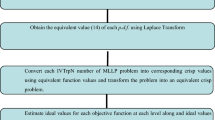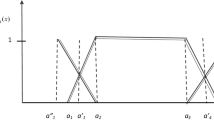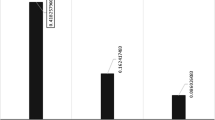Abstract
Neutrosophic set theory plays an important role in dealing with the impreciseness and inconsistency in data encountered in solving real life problems. This article aims to present a novel goal programming based strategy which will be helpful to solve Multi-Level Multi-Objective Linear Programming Problem (MLMOLPP) with parameters as neutrosophic numbers (NNs). Difficulty in decision making arises due to the presence of multiple decision makers (DMs) and impreciseness in information. Here each level DM has multiple linear objective functions with parameters considered as NNs which are represented in the form \(c + dI\), where c and d are considered real numbers and the symbol I denotes indeterminacy. The constraints are also linear with the parameters as NNs. Firstly the NNs are changed into intervals and the problem turns into a multi-level multi-objective linear programming problem considering interval parameters. Then interval programming technique is employed to obtain the target interval of each objective function. In order to avoid decision deadlock which may arise in hierarchical (multi-level) problem, a possible relaxation is imposed by each level DM on the decision variables under his/her control. Finally a goal programming strategy is presented to solve the MLMOLPP with interval parameters. The method presented in this paper facilitates to solve MLMOLPP with multiple conflicting objectives in an uncertain environment represented through NNs of the form \(c + dI\), where indeterminacy I plays a pivotal role. Lastly, a mathematical example is solved to show the novelty and applicability of the developed strategy.


Similar content being viewed by others
References
Abou-El-Enien THM, El-Feky SF (2018) Compromise solutions for fuzzy multi-level multiple objective decision making problems. Am J Comput Appl Math 8(1):1–14
Atanassov KT (1986) Intuitionistic fuzzy sets. Fuzzy Sets Syst 20(1):87–96
Baky IA (2010) Solving multi-level multi-objective linear programming problems through fuzzy goal programming approach. Appl Math Model 34(9):2377–2387
Baky IA, Eid MH, Elsayed MA (2014) Bi-level multi-objective programming problem with fuzzy demands: a fuzzy goal programming algorithm. J Oper Res Soc India (OPSEARCH) 51(2):280–296
Banaeian N, Mobli H, Fahimnia B, Nielsen IE, Omid M (2018) Green supplier selection using fuzzy group decision making methods: a case study from the agri-food industry. Comput Oper Res 89(C):337–347
Banerjee D, Pramanik S (2018) Single-objective linear goal programming problem with neutrosophic numbers. Int J Eng Sci Res Technol 7:454–469
Biswas P, Pramanik S, Giri BC (2014a) Entropy based grey relational analysis method for multi-attribute decision making under single valued neutrosophic assessments. Neutrosophic Sets Syst 2:105–113
Biswas P, Pramanik S, Giri BC (2014b) A new methodology for neutrosophic multi-attribute decision-making with unknown weight information. Neutrosophic Sets Syst 3:42–50
Broumi S, Smarandache F (2014) Single valued neutrosophic trapezoid linguistic aggregation operators based multi-attribute decision making. Bull Pure Appl Sci Math Stat 33E(2):135–155
Charnes A, Cooper WW, Ferguson A (1955) Optimal estimation of executive compensation by linear programming. Manag Sci 1(2):138–151
Dey PP, Pramanik S, Giri BC (2014a) Multilevel fractional programming problem based on fuzzy goal programming. Int J Innov Res Tech Sci 2:17–26
Dey PP, Pramanik S, Giri BC (2014b) TOPSIS approach to linear fractional bi-level MODM problem based on fuzzy goal programming. J Ind Eng Int 10(4):173–184
Emam OE, Abdo AM, Bekhit NM (2016) A multi-level multi-objective quadratic programming problem with fuzzy parameters in constraints. Int J Eng Res Dev 12(4):50–57
Kong L, Wu Y, Ye J (2015) Misfire fault diagnosis method of gasoline engines using the cosine similarity measure of neutrosophic numbers. Neutrosophic Sets Syst 8:42–45
Lachhwani K (2014) On solving multi-level multi objective linear programming problems through fuzzy goal programming approach. Opsearch 51(4):624–637
Liu P, Liu X (2018) The neutrosophic number generalized weighted power averaging operator and its application in multiple attribute group decision making. Int J Mach Learn Cybern 9(2):347–358
Liu QM, Yang YM (2018) Interactive programming approach for solving multi-level multi-objective linear programming problem. J Intell Fuzzy Syst 35(1):55–61
Liu P, Liu J, Merigó JM (2018) Partitioned Heronian means based on linguistic intuitionistic fuzzy numbers for dealing with multi-attribute group decision making. Appl Soft Comput 62:395–422
Liu S, Zhang DG, Liu XH, Zhang T, Gao JX, Cui YY (2019) Dynamic analysis for the average shortest path length of mobile ad hoc networks under random failure scenarios. IEEE Access 7:21343–21358
Mondal K, Pramanik S (2015) Neutrosophic decision making model of school choice. Neutrosophic Sets Syst 7:62–68
Mondal K, Pramanik S, Giri BC, Smarandache F (2018) NN-Harmonic mean aggregation operators-based MCGDM strategy in a neutrosophic number environment. Axioms. https://doi.org/10.3390/axioms7010012
Moore RE (1998) Interval analysis. Prentice-Hall, New Jersey
Morente-Molinera JA, Kou G, Peng Y, Torres-Albero C, Herrera-Viedma E (2018) Analysing discussions in social networks using group decision making methods and sentiment analysis. Inf Sci 447:157–168
Morente-Molinera JA, Kou G, Samuylov K, Ureña R, Herrera-Viedma E (2019) Carrying out consensual Group Decision Making processes under social networks using sentiment analysis over comparative expressions. Knowl Based Syst 165:335–345
Osman MS, Emam OE, El Sayed MA (2017) Stochastic fuzzy multi-level multi-objective fractional programming problem: a FGP approach. Opsearch 54(4):816–840
Osman MS, Emam OE, El Sayed MA (2018) Solving multi-level multi-objective fractional programming problems with fuzzy demands via FGP approach. Int J Appl Comput Math 4:41
Pérez IJ, Cabrerizo FJ, Alonso S, Dong YC, Chiclana F, Herrera-Viedma E (2018) On dynamic consensus processes in group decision making problems. Inf Sci 459:20–35
Pramanik S (2012) Bilevel programming problem with fuzzy parameters: a fuzzy goal programming approach. J Appl Quant Methods 7(1):9–24
Pramanik S, Banerjee D (2018) Neutrosophic number goal programming for multi-objective linear programming problem in neutrosophic number environment. MOJ Res Rev 1(3):135–141
Pramanik S, Chakrabarti SN (2013) A study on problems of construction workers in West Bengal based on neutrosophic cognitive maps. Int J Innov Res Sci Eng Technol 2(11):6387–6394
Pramanik S, Dey PP (2011) Bi-level linear fractional programming problem based on fuzzy goal programming approach. Int J Comput Appl 25(11):34–40
Pramanik S, Dey PP (2018) Bi-level linear programming problem with neutrosophic numbers. Neutrosophic Sets Syst 21:110–121
Pramanik S, Dey PP, Roy TK (2012) Fuzzy goal programming approach to linear fractional bilevel decentralized programming problem based on Taylor series approximation. J Fuzzy Math 20:231–238
Pramanik S, Banerjee D, Giri BC (2015) Multi-level multi-objective linear plus linear fractional programming problem based on FGP approach. Int J Innov Sci Eng Technol 2(5):171–177
Pramanik S, Roy R, Roy TK (2017) Teacher selection strategy based on bidirectional projection measure in neutrosophic number environment. In: Smarandache F, Abdel-Basset M, El-Henawy I (eds) Neutrosophic operational research, vol 2. Pons Publishing House/Pons asbl, Bruxelles, pp 29–53
Ramadan K (1996) Linear programming with interval coefficients. Doctoral dissertation, Carleton University
Shaocheng T (1994) Interval number and fuzzy number linear programming. Fuzzy Sets Syst 66(3):301–306
Shi L, Ye J (2017) Cosine measures of linguistic neutrosophic numbers and their application in multiple attribute group decision-making. Information 8(4):117. https://doi.org/10.3390/info8040117
Smarandache F (1998) A unifying field in logics: neutrosophic logic. Neutrosophy, Neutrosophic set, neutrosophic probability and statistics. American Research Press, Rehoboth
Smarandache F (2013) Introduction of neutrosophic statistics. Sitech and Education Publisher, Craiova
Smarandache F (2015) (t, i, f)-Neutrosophic structures & I-neutrosophic structures (revisited). Neutrosophic Sets Syst 8:3–9
Wang H, Smarandache F, Zhang YQ, Sunderraman R (2010) Single valued neutrosophic sets. Multispace and Multistruct 4:410–413
Ye J (2016a) Multiple attribute group decision making method under neutrosophic number environment. J Intell Syst 25(3):377–386
Ye J (2016b) Fault diagnoses of steam turbine using the exponential similarity measure of neutrosophic numbers. J Intell Fuzzy Syst 30(4):1927–1934
Ye J (2017) Bidirectional projection method for multiple attribute group decision making with neutrosophic numbers. Neural Comput Appl 28(5):1021–1029
Ye J (2018a) Neutrosophic number linear programming method and its application under neutrosophic number environments. Soft Comput 22(14):4639–4646
Ye J (2018b) Multiple attribute decision-making methods based on the expected value and the similarity measure of hesitant neutrosophic linguistic numbers. Cogn Comput 10(3):454–463
Ye J, Chen J, Yong R, Du S (2017) Expression and analysis of joint roughness coefficient using neutrosophic number functions. Information 8(2):69. https://doi.org/10.3390/info8020069
Ye J, Cui W, Lu Z (2018) Neutrosophic number nonlinear programming problems and their general solution methods under neutrosophic number environments. Axioms 7(1):13. https://doi.org/10.3390/axioms7010013
Zadeh LA (1965) Fuzzy sets. Inf Control 8(3):338–353
Zhang DG (2012) A new approach and system for attentive mobile learning based on seamless migration. Appl Intell 36(1):75–89
Zhang DG, Liang YP (2013) A kind of novel method of service-aware computing for uncertain mobile applications. Math Comput Model 57(3–4):344–356
Zhang DG, Zhang XD (2012) Design and implementation of embedded un-interruptible power supply system (EUPSS) for web-based mobile application. Enterp Inf Syst 6(4):473–489
Zhang DG, Kang X, Wang J (2012a) A novel image de-noising method based on spherical coordinates system. EURASIP J Adv Signal Process 2012:110
Zhang D, Zhao CP, Liang YP, Liu ZJ (2012b) A new medium access control protocol based on perceived data reliability and spatial correlation in wireless sensor network. Comput Electr Eng 38(3):694–702
Zhang DG, Zhu YN, Zhao CP, Dai WB (2012c) A new constructing approach for a weighted topology of wireless sensor networks based on local-world theory for the Internet of Things (IOT). Comput Math Appl 64(5):1044–1055
Zhang DG, Li G, Zheng K, Ming X, Pan ZH (2014a) An energy-balanced routing method based on forward-aware factor for wireless sensor networks. IEEE Trans Ind Inf 10(1):766–773
Zhang DG, Wang X, Song X, Zhao D (2014b) A novel approach to mapped correlation of ID for RFID anti-collision. IEEE Trans Serv Comput 7:741–748
Zhang DG, Wang X, Song XD (2015a) New medical image fusion approach with coding based on SCD in wireless sensor network. J Electr Eng Technol 10(6):2384–2392
Zhang DG, Wang X, Song XD, Zhang T, Zhu YN (2015b) A new clustering routing method based on PECE for WSN. EURASIP J Wirel Commun 2015:162
Zhang DG, Zheng K, Zhang T, Wang X (2015c) A novel multicast routing method with minimum transmission for WSN of cloud computing service. Soft Comput 19(7):1817–1827
Zhang DG, Zheng K, Zhao DX, Song XD, Wang X (2016) Novel quick start (QS) method for optimization of TCP. Wirel Netw 22(1):211–222
Zhang DG, Liu S, Zhang T, Liang Z (2017a) Novel unequal clustering routing protocol considering energy balancing based on network partition and distance for mobile education. J Netw Comput Appl 88:1–9
Zhang DG, Niu HL, Liu S (2017b) Novel PEECR-based clustering routing approach. Soft Comput 21(24):7313–7323
Zhang DG, Chen C, Cui YY, Zhang T (2018a) New method of energy efficient subcarrier allocation based on evolutionary game theory. Mobile Netw Appl. https://doi.org/10.1007/s11036-018-1123-y
Zhang DG, Liu S, Liu XH, Zhang T, Cui YY (2018b) Novel dynamic source routing protocol (DSR) based on genetic algorithm-bacterial foraging optimization (GA-BFO). Int J Commun Syst 31(18):1–20
Zhang DG, Tang YM, Cui YY, Gao JX, Liu XH, Zhang T (2018c) Novel reliable routing method for engineering of internet of vehicles based on graph theory. Eng Comput 36(1):226–247
Zhang DG, Zhang T, Dong Y, Liu XH, Cui YY, Zhao DX (2018d) Novel optimized link state routing protocol based on quantum genetic strategy for mobile learning. J Netw Comput Appl 122:37–49
Zhang DG, Zhang T, Zhang J, Dong Y, Zhang XD (2018e) A kind of effective data aggregating method based on compressive sensing for wireless sensor network. J Wirel Comput Netw 2018:159
Zhang DG, Zhou S, Tang YM (2018f) A low duty cycle efficient MAC protocol based on self-adaption and predictive strategy. Mobile Netw Appl 23(4):828–839
Zhang DG, Gao JX, Liu XH, Zhang T, Zhao DX (2019a) Novel approach of distributed and adaptive trust metrics for MANET. Wirel Netw 25(6):3587–3603
Zhang DG, Ge H, Zhang T, Cui YY, Liu X, Mao G (2019b) New multi-hop clustering algorithm for vehicular ad hoc networks. IEEE Trans Intell Transp Syst 20:1517–1530
Zhang DG, Zhang T, Liu X (2019c) Novel self-adaptive routing service algorithm for application in VANET. Appl Intell 49(5):1866–1879
Zhang T, Zhang DG, Qiu J, Zhang X, Zhao P, Gong C (2019d) A kind of novel method of power allocation with limited cross-tier interference for CRN. IEEE Access 7:82571–82583
Zheng E, Teng F, Liu P (2017) Multiple attribute group decision-making method based on neutrosophic number generalized hybrid weighted averaging operator. Neural Comput Appl 28(8):2063–2074
Acknowledgements
The first author expresses her heartfelt gratitude towards Department of Science and Technology, Govt. of India for providing financial assistantship through Inspire fellowship.
Author information
Authors and Affiliations
Corresponding author
Ethics declarations
Conflict of interest
The authors state that there is no conflict of interest.
Additional information
Publisher's Note
Springer Nature remains neutral with regard to jurisdictional claims in published maps and institutional affiliations.
Rights and permissions
About this article
Cite this article
Maiti, I., Mandal, T. & Pramanik, S. Neutrosophic goal programming strategy for multi-level multi-objective linear programming problem. J Ambient Intell Human Comput 11, 3175–3186 (2020). https://doi.org/10.1007/s12652-019-01482-0
Received:
Accepted:
Published:
Issue Date:
DOI: https://doi.org/10.1007/s12652-019-01482-0




